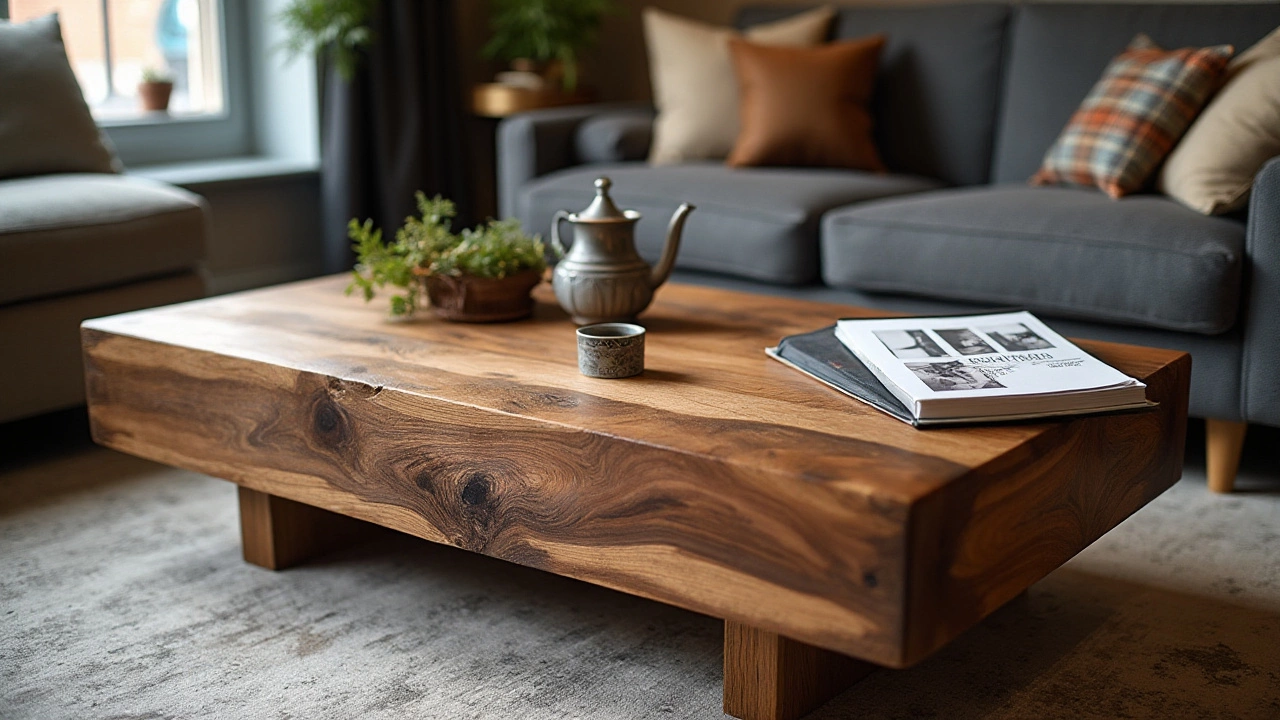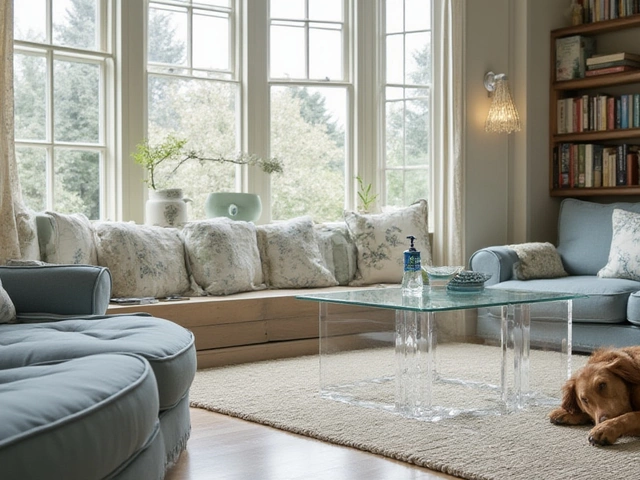 16
Dec,2024
16
Dec,2024
Deciding on the right wood thickness for your coffee table crafts a balance between elegance and strength. The thickness you select will have a significant impact on both the character and functionality of the table central to any living room.
With a myriad of influences to consider, like the wood type and the table's intended use, making the right choice can elevate the style of your space or enhance its practicality. Whether you're piecing together your own creation or buying a standout piece, understanding these aspects will bring your vision to life.
Understanding Wood Types
When embarking on the journey to craft or select the perfect coffee table, the choice of wood is foundational. The type of wood you choose will not only determine the table's appearance but also its durability and how it interacts over time with the conditions in your home. Hardwood varieties like oak, mahogany, and walnut are often favored for their strength and rich grain patterns. These woods inherently provide a robust structure, crucial for tables that endure daily use.
Oak, for instance, is cherished for its density and prominent grain, which can give a rustic yet timeless look. Lovers of deep, dark tones might gravitate towards mahogany, which is renowned for its natural reddish-brown hue and smooth texture. However, it's crucial to note that hardwoods like these often require thicker cuts to maintain their innate strength. The optimal thickness might start from one inch and go beyond, depending on the table's size and function. On the other hand, softer woods like pine or cedar are lighter and might provide a different aesthetic with their softer grains. While they may allow for thinner designs, they require additional sealing to protect against dents and scratches.
The variety of wood also influences the weight of the coffee table. A solid oak table will be considerably heavier than one made from pine. This weight not only affects the ease with which the table can be moved but offers stability that's pivotal for preventing accidental tipping. Some woodworkers emphasize the importance of choosing a wood type that complements the climate where the table will reside, as humidity and temperature variations can cause expansion or contraction.
"It's important to respect the natural properties of the material you're working with," advises renowned furniture craftsman John Dickinson. "Understanding how wood interacts with its environment allows you to create furniture that stands the test of time."
For those embracing an eco-friendly approach, reclaimed wood offers a compelling alternative. These pieces, often sourced from old barns or shipping containers, provide a unique narrative to each creation. They usually come with pre-determined thicknesses and may present a versatile appearance, enriched with historical imperfections. Combining different types of wood in a single table can also yield striking results, weaving together different textures and colors to create a centerpiece full of character.
To assist in choosing the best wood type, it's helpful to gather information about each type's qualities and how they can fit into your design ethos and practical needs. Here's a guide to some popular choices:
- Oak: Dense and robust with a traditional grain, ideal for durable tables.
- Walnut: Dark with fine grains, providing a modern and luxurious appearance.
- Pine: Light and youthful with a soft grain, perfect for a casual or rustic look.
- Cedar: Naturally resistant to decay, often lighter with a unique fragrance.
One more thing to keep in mind is the finish. Whatever wood you select, finishing treatments can alter its final appearance significantly. Natural oils and waxes preserve the raw grain, while stains and varnishes can dramatically change the table’s appearance to align with your home decor. By embracing the diverse world of wood types, you gain a deeper appreciation of the craft and heritage behind your coffee table, ensuring it brings warmth and functionality to your space.

Design and Aesthetics
The art of selecting the right wood thickness for a coffee table goes beyond mere functionality. It's a journey into style, personality, and the specific vibe you aim to emanate within your living space. The thickness of wood can significantly alter the visual weight of your table. A slender tabletop, for instance, often gives a minimalist, airy feel, optimal for modern or mid-century settings. In contrast, a substantial slab presents a bold, rustic appeal, suggesting durability and a robust character that fits well in farmhouse or industrial-decorated rooms. Picking the right thickness can reflect personal taste while complementing existing furniture, ensuring harmony throughout the room.
When diving deeper into the aesthetics, consider the finish applied to the wood. The kind of stain or varnish not only enhances the natural grain and color but also defines a particular ambiance. A rich mahogany stain on a thick wooden slab might evoke warmth and luxury, while a lighter, natural finish could inspire a fresh, Scandinavian vibe. It's these subtle details that blend together, giving depth and interest to a room's overall decor. Experts often argue that choosing wood thickness should coincide with the type of finish for a holistic design approach.
The dimensions of the room where the coffee table will reside should not be overlooked. In a large room, a bigger and thicker coffee table design can serve as a stunning focal point, counteracting any excess space and creating a sense of balance. On the other hand, in smaller areas, a thinner tabletop can conserve visual space, preventing the room from feeling cluttered or overwhelmed. Another tip is to use proportional rules when deciding the size and thickness; commonly, a coffee table should be about two-thirds the size of your sofa for optimal scale.
Color and shading can drastically transform the perception of thickness as well. A table with a consistent tone might feel flat, whereas using varying shades within the wood or combining different materials can play tricks with the eye and provide a subtle dynamic effect. For example, the contrast between light and dark shades in wood can highlight its natural beauty and break any monotony.
“A coffee table, although a simple piece of furniture, is a powerful storytelling element within a room,” said interior design expert Nathan Turner in his bestseller on home styling.
For those looking to innovate, incorporating mixed materials such as metal, glass, or even auxiliary woods in the base or legs can offer an additional layer of sophisticated creativity. This method allows for diverse visual textures and can make or reincarnate a space to feel eclectic or industrial. Choices like a wooden top paired with steel legs can be especially intriguing and add a distinguished edge to contemporary layouts.

Structural Integrity
Building a coffee table with the right wood thickness is akin to laying a strong foundation for a house. It dictates how well the structure holds up over time and endures the weight of objects placed upon it. The coffee table is more than just a decorative piece in your living room; it is a functional element that sees frequent use. Thus, ensuring its structural integrity is paramount. Generally, a wood thickness of about 1 to 2 inches is sufficient for most coffee tables, providing a balance between sturdiness and elegance. Thicker pieces, however, can add a bold, substantial feel to the design. A thinner top might appeal for a sleek modern profile, but it risks warping or splitting under pressure.
Wood selection also plays a crucial role in this equation. Hardwoods like oak, maple, and walnut are esteemed for their durability and ability to withstand wear and tear. These woods are less prone to dents and scratches, thus preserving both the beauty and functionality of your table over time. Opting for these robust options might be more expensive upfront, but their longevity can be truly cost-effective in the long run. Softwoods, though lightweight and often aesthetically pleasing, require careful consideration of thickness to achieve the necessary stability.
Consider the spatial dynamics and the intended use of the coffee table as well. If it's frequently used for hosting gatherings or family events, the structural integrity becomes even more important. Balance is crucial; too much thickness might be an overkill, weighing down the aesthetic, while too little might compromise the table's purpose. As an additional tip, reinforcing the structure with braces or opting for a design with cross beams can enhance its strength without detracting from its appeal.
"The quality of a piece of furniture not only reflects the choice of wood but also the care in its construction," notes renowned interior designer Jamie Drake.The integration of mortise and tenon joints can further solidify the frame, providing a seamless look that's both traditional and effective. These joints are interlocked and therefore add to the rigidity, which is particularly beneficial for coffee tables that might routinely support a significant load.
Moreover, considering the climate and indoor environment notably impacts the decision about thickness. Wood naturally expands and contracts with varying humidity levels, and thicker pieces might offer more resistance to these changes, safeguarding the table’s lifespan. This aspect is crucial when placing a coffee table in areas with significant seasonal shifts, ensuring it remains both a functional and aesthetic component of your living space.

DIY Considerations
Embarking on a DIY coffee table project is an exciting journey that blends creativity with functionality. Starting with the choice of wood thickness, it is crucial to strike a balance between style and strength. Typically, a thickness ranging from 3/4 to 1 1/2 inches is common for coffee tables. This range offers enough heft for stability while maintaining a sleek silhouette. If you're using hardwoods such as oak or maple, they provide incredible robustness even at thinner measurements, whereas softer woods might require a thicker cut to ensure longevity.
Choosing the correct tools and techniques is equally important. For cutting and shaping the wood, power tools like a circular saw or a jigsaw are invaluable. Ensure that you have a reliable drill and a set of sandpapers ranging from coarse to fine grit for smoothing the surfaces. It's important to establish a dedicated workspace that is safe and spacious enough to accommodate all of your activities without causing unnecessary discomfort or risk. Protect yourself with safety goggles and ensure proper ventilation if varnishing or sealing the wood.
Considering finish options is another exciting step. Whether you prefer the rustic charm of a natural wood finish or the polished look of a lacquered surface, these choices can dramatically alter the table's final appearance. Experts often recommend applying a varnish or sealant to protect the wood from daily wear and tear, ensuring your coffee table remains a centerpiece in your home for years to come. As renowned furniture designer Jens Risom once noted,
“Good design means that anything with a functional aspect should be appealing.”This reflects that your materials should not only serve a purpose but also visually engage those who encounter them.
Budgeting and Materials
Budgeting plays a significant role in the DIY process. High-quality wood can be costly, yet it pays off with superior durability and aesthetics. Therefore, calculate the cost-effectiveness of your project before purchasing materials. You can save money by exploring local lumber yards for deals or by opting for reclaimed wood which adds a unique history and charm to your piece. Also, consider potential costs for screws, brackets, and finishes. Items like table legs or additional decor elements may also add to your list.
| Wood Type | Average Cost per Board Foot |
|---|---|
| Oak | $6 |
| Maple | $7 |
| Walnut | $10 |
These basic steps empower you to transform a mere piece of wood into a cherished family fixture. Remember, crafting your table allows for a personal touch that reflects your unique style and creativity while ensuring that your living space is both functional and inviting. Every decision, from wood selection to finishing, contributes to a one-of-a-kind masterpiece.




